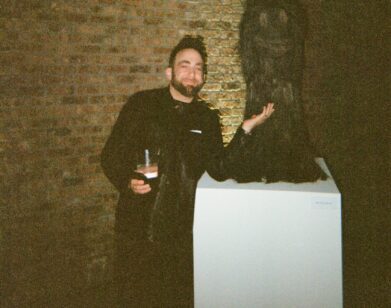Karen Shepard’s Experiment Fiction

ABOVE: KAREN SHEPARD. IMAGE COURTESY OF BARRY GOLDSTEIN
Erotic tension simmers and cultures clash when a group of strangers appear in an insular, straitlaced New England town in 1870. The new arrivals are 75 “Chinamen,” as the newspapers tag them, none older than 22, hired by wealthy industrialist Calvin Sampson as strikebreakers; rebellious locals have demanded higher wages, and he expects they’ll disrupt the union organizers. Seemingly quiet and polite to a fault, the Chinese immigrants will do what the Americans won’t: make shoes without getting uppity. But as the new men begin to adapt, startling changes creep in.
Based on a true incident known as “the Chinese experiment,” this majestic novel by the singular Karen Shepard gives American history an electrifying intimacy, charged with desire and fear. Sparks fly as the “exotic” men find themselves the center of attention. Circling warily are the scores of women who are recruited to teach them English in Sunday school. They engage in behavior otherwise forbidden: flirtatious laughter; unchaperoned walks in the countryside; the exchange of gifts. Ignoring this powder keg are the local men, too smug and xenophobic to click. When they fatally underestimate the newcomers’ power of attraction, scandal threatens.
LISA DIERBECK: Was there a single event that made you want to write this novel?
KAREN SHEPARD: I knew about the workers because we live in the neighboring town. I went to a lecture by the art historian Tony Lee, who’d written a scholarly book about the photographs of the Chinese workers [A Shoemaker’s Story: Being Chiefly about French Canadian Immigrants, Enterprising Photographers, Rascal Yankees, and Chinese Cobblers in a Nineteenth Century Factory Town]. A group photograph was taken of the workers on the day they arrived. Tony’s book is a cultural and art critique of what that photo meant. I brought my then-toddler daughter to the lecture—she was distracted—and I took notes on deposit slips in my checkbook register. It was a great story.
DIERBECK: It must have been a huge research job. The bibliography is pages long.
SHEPARD: I’d never done anything like that. Nothing of this scope. I kept asking: How do I get a voice that’s coming from this time? I had the transcript from Sampson [the factory owner]. I had his voice, albeit his official voice. He gets angry in that interview, so he’s not as guarded as he might have been. The reporters were interested in finding out if he’d mistreated the striking union workers. The suggestion that he was at fault put him over the edge. The voice was huge.
DIERBECK: Why is the narrator über-omniscient?
SHEPARD: One of the literary influences was Edward P. Jones’ The Known World. I admired the emotional complexity of it, of the black slave owners. It doesn’t fit into good guys and bad guys easily. The voice is omniscient, and it can time travel. There was an injection of 75 strange alien beings into a relatively insular community. Their arrival means different things to different people. You need the ability to go into different points of view. Everyone is looking at these people. I wanted to capture that.
DIERBECK: It’s a kaleidoscopic view of the village.
SHEPARD: Yes. Jim [Shepard’s husband, the author Jim Shepard] teases me that omniscient is the point of view I’m meant to have because I’m so bossy. It was this huge event for 10 years, with more than 200 Chinese living in North Adams—the biggest community of Asians, other than New York, east of the Mississippi at the time. By 1880, all but two of the workers are gone. There’s a giant ballooning, a deflation, then disappearing. It was a very early response to people who are “Other.” I wanted to give the readers and characters the chance to become more understanding. I wanted that sense of hindsight, that we wouldn’t have called them “boys” or thought they were sexually harmless had we known then what we know now. The characters have the chance to change and to look back, embarrassed.
DIERBECK: The factory owner’s wife has a mixed-race baby. Was that true?
SHEPARD: The mixed-race baby is fictional. Julia was childless. Her losing 13 pregnancies and her need for a child became central to the story. She must have tried and not been able to. That was emotionally moving. I started to think about what a failure she must have felt like, for a woman of her time.
DIERBECK: What led you to include actual photographs?
SHEPARD: I was fascinated with this notion that these people were largely forgotten. They were thought of as a group, not individuals. It’s hard to find a list in census records of their names. They were just thought of as a teeming mass of Asian guys. The photos are a gentle indictment of all of us. Let’s remember these were individuals and they were here. It’s a resurrection. We have no idea what became of them. I felt their eyes were on me when I was writing the book, and I wanted the reader to have some similar sensation.
DIERBECK: The women are permitted all sorts of unthinkable liberties. Why?
SHEPARD: They’re blind to these young men’s effect on young unmarried women. The blindness is a form of racism. They don’t see these Chinese people as a sexual threat—it’s an emasculation of them. Of course, sparks are going to fly. It’s a kind of paternalistic racism. Sampson has the same kind of feeling by calling them his “boys,” like they were a passel of school kids. That they’d be sexual was not ever thought of. There’s a description in a newspaper of a Chinese laborer wearing “a natty little shoe.” Like a doll. It’s inconceivable to Sampson that one of these guys would be sexual with his wife. That’s part of why he’s so destroyed by it. They weren’t thinking of them as real men. They didn’t behave the way men in this community behaved. They didn’t brawl. Ida was drawn to Charlie [the Chinese foreman]. Because, unlike other men, he wasn’t on the verge of violence. Irish women married Chinese men starting way back in the 1840s in New York City. It was a no-brainer. They don’t beat us! They don’t drink! Let’s marry them!
THE CELESTIALS IS OUT NOW.






